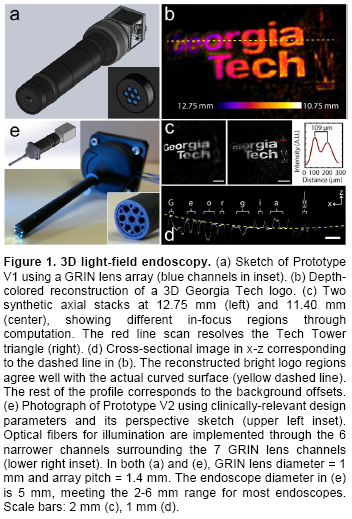Georgia Tech inventors have created the first quantitative 3D endoscope, using light-field acquisition and reconstruction. It is a 3D endoscope using anywhere between 3 to 7 customizable gradient index (GRIN) lenses and fiber channels to capture the image. Furthermore, this endoscope utilizes an algorithm that helps to create a 3D image on the screen. Currently, surgeons use a 2D endoscope that has only one GRIN lens; and if they want a 3D image, surgeons have to use 3D glasses. As a newly discovered imaging scheme, light-field imaging allows for scanning-free, volumetric and scalable acquisition and reconstruction of 3D data. They have established both hardware prototypes and software for the system. The system has been validated both theoretically and experimentally, allowing for imaging and reconstructing a 5mm × 5mm × 10mm volume with a 50-100 μm lateral resolution and a 100-200 μm axial resolution. The algorithm allows for volumetric reconstruction, and the eventual goal is to have real-time visualization. Such an algorithmic framework is currently being tested. The inventors claim that the light-field scheme allows the scope to be designed for either adults or kids, as well as for various body parts such as the brain or kidney.
- Measurements: system achieves 'true quantitative' 3D information
- Imaging and visualization: system brings a great potential for fast 3D quantitative imaging, visualization, and synthesis of the focal stacks
- Material: method is glass-free
- Clinical and pediatric endoscopy
- Bronchoscopy
- Colonoscopy
- Laryngoscopy
- Etc.
Endoscopes are indispensable tools used for clinical diagnosis or surgical guidance. However, conventional endoscopes in the clinical practice are mostly 2D, and the existing 3D techniques only provide the stereotype of perspective views. A true quantitative 3D endoscope is still lacking in great demand, especially for surgeries in dense areas such as the brain, blood vessels and tumors, where the physicians need the quantitative 3D information to accurately operate on the pathological parts. Here, the inventors have developed novel 3D endoscopy using light-field imaging strategies.

